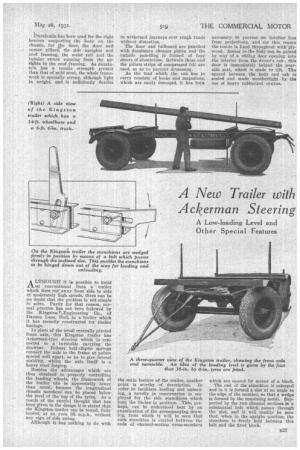A New Trailer with Ackerman Steering
Page 45

If you've noticed an error in this article please click here to report it so we can fix it.
A Low-loading Level and Other Special Features
ALTriOUGH it is possible to build on conventional lines a trailer which does not; sway from side to side at moderately high speeds, there can be no doubt that the problem is not simple to solve. Partly for that reason, normal practice has not been followed by the Kingston i,Engineering Co., of Denson Lane, Hull, in a trailer which it has recently constructed for timber
haulage. '
In place of the usual centrally pivoted front axle, this Kingston trailer has Ackerman-type steering which is connected to a turntable carrying the drawbar. Robust half-elliptic springs connect the axle to the frame at points spaced well apart, so as to give lateral stability, whilst the axle itself is a, heavy steel forging.
Besides the advantages which are thus obtained in properly controlling the leading wheels, the framework of the trailer crin be appreciably lower than usual, because the longitudinal chassis members can be placed below the level of the top of the tyres. As a result of the careful thought that has been given to the design it is stated that the Kingston trailer can be towed, fully loaded, at an even SG. m.p.h., without any sign of side swing. Although it has nothing to do with
the main feature of the trailer, another point is worthy of description. In order to facilitate loading and unloading, .a novelty in construction is employed for the side stanchions which keep the tin.ber in position. This, perhaps, can be understood best by an examination of the accompanying drawing, from which it will be seen that each stanchion is carried between the ends of channel-section cross-members
which are spaced by means of a block.
The end of the stanchion is enlarged and in it is formed a slot at an angle to the edge of the member, so that a wedge is formed by the remaining metal. Supported by the two channel sections is a substantial bolt which passes through the slot, and it will readily be seen that, when in the upright position, the stanchion is firmly held between this bolt and the fixed block.




































































































